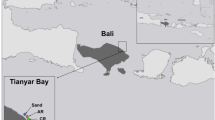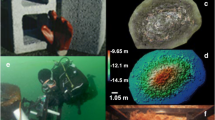Abstract
Artificial reefs (AR) have been deployed below commercial fish farms in tropical, subtropical and temperate marine locations in an effort to reduce some of the negative effects of aquaculture, and this study describes an AR deployment at a boreal site. This study examined the development and succession of two benthic communities on artificial reefs in the Icelandic fjord, Skutulsfjörður. Two plastic, triangle-shaped, porous artificial reefs were moored on the seafloor: a) below a cod farm and b) at a nearby reference site, and were monitored for 4 months, on a bi-weekly basis by SCUBA divers. Monitoring included both visual observations, mainly of the motile biota, and subsampling of the fouling community by removing pieces of plastic mesh that were attached to the reefs for this purpose. Diverse biological communities developed on the artificial reefs at both fish farm and reference sites; however, overall species richness, abundance and sessile species cover were consistently greater at the farm site. Although the biota recorded were typical boreal species, many of the same taxa observed in warmer waters, in similar studies, were found on these reefs. Artificial reefs are one of many options that may be considered to enhance the sustainability of coastal aquaculture, and we suggest that: a) ARs should be studied over the course of a year or more, and b) efforts should be made to consider how we may harvest the biota associated with the ARs for commercial use.








Similar content being viewed by others
References
Aguado-Giménez F, Piedecausa M, Carrasco C et al (2011) Do benthic biofilters contribute to sustainability and restoration of the benthic environment impacted by offshore cage finfish aquaculture? Mar Pollut Bull 62:1714–1724. doi:10.1016/j.marpolbul.2011.05.028
Aleem AA (1957) Succession of marine fouling organisms on test panels immersed in deep-water at La Jolla, California. Hydrobiologia 11:40–58
Angel DL, Spanier E (2002) An application of artificial reefs to reduce organic enrichment caused by net-cage fish farming: preliminary results. ICES J Mar Sci 59:S324–S329. doi:10.1006/jmsc.2002.1208
Angel DL, Eden N, Breitstein S et al (2002) In situ biofiltration: a means to limit the dispersal of effluents from marine finfish cage aquaculture. Hydrobiologia 469:1–10
Antsulevich A (1994) Artificial reefs project for improvement of water quality and environmental enhancement of Neva Bay (St.-Petersburg County Region). Bull Mar Sci 55:1189–1192
Brault S, Bourget E (1985) Structural changes in an estuarine sub-tidal epibenthic community biotic and physical causes. Mar Ecol Prog Ser 21:63–73. doi:10.3354/meps021063
Cook EJ, Black KD, Sayer MDJ et al (2006) The influence of caged mariculture on the early development of sublittoral fouling communities: a pan-European study. ICES J Mar Sci 63:637–649. doi:10.1016/j.icesjms.2005.12.007
Gao QF, Shin PKS, Lin G et al (2006) Stable isotope and fatty acid evidence for uptake of organic waste by green-lipped mussels Perna viridis in a polyculture fish farm system. Mar Ecol Prog Ser 317:273–283
Gao QF, Shin PKS, Xu WZ, Cheung SG (2008) Amelioration of marine farming impact on the benthic environment using artificial reefs as biofilters. Mar Pollut Bull 57:652–661. doi:10.1016/j.marpolbul.2008.02.033
Hoover RA, Armour R, Dow I, Purcell JE (2012) Nudibranch predation and dietary preference for the polyps of Aurelia labiata (Cnidaria: Scyphozoa). Hydrobiologia 690:199–213. doi:10.1007/s10750-012-1044-x
Ingólfsson O (2008) The dynamic climate in Iceland. https://notendur.hi.is/~oi/climate_in_iceland.htm. Accessed 5 Jun 2011
Jensen A (2002) Artificial reefs of Europe: perspective and future. ICES J Mar Sci 59:3–13. doi:10.1006/jmsc.2002.1298
Karakassis I, Tsapakis M, Hatziyanni E et al (2000) Impact of cage farming of fish on the seabed in three Mediterranean coastal areas. ICES J Mar Sci 57:1462–1471. doi:10.1006/jmsc.2000.0925
Leitão F (2013) Artifical reefs: from ecological processes to fishing enhancement tools. Braz J Oceanogr 61:77–81
Naylor RL, Goldburg RJ, Primavera JH et al (2000) Effect of aquaculture on world fish supplies. Nature 405:1017–1024. doi:10.1038/35016500
Olsen LM, Holmer M, Olsen Y (2008) Perspectives of nutrient emission from fish aquaculture in coastal waters: literature review with evaluated state of knowledge. The Fishery and Aquaculture Industry Research Fund (FHF), p 87. www.fiskerifond.no/files/projects/attach/fhfnutrients_and_aquaculture.pdf
Pearson T, Black KD (2001) The environmental impact of marine fish cage culture. In: Black KD (ed) Environ. Impacts Aquac. Sheffield Academic Press, Sheffield, pp 1–31
Pearson TH, Rosenberg R (1978) Macrobenthic succession in relation to organic enrichment and pollution of the marine environment. Oceanogr Mar Biol Annu Rev 16:229–311. doi:10.1111/j.1540-5834.2012.00707.x
Shin PKS, Gao Q, Cheung SG (2011) Nutrient assimilation by organisms on artificial reefs in a fish culture (example of Hong Kong). In: Faruk A (ed) Recent Advances in Fish Farms. http://www.intechopen.com/books/recent-advances-in-fish-farms/nutrient-assimilation-by-organisms-on-artificial-reefs-in-a-fish-culture-example-of-hong-kong-
Tsagaraki TM, Pitta P, Frangoulis C et al (2013) Plankton response to nutrient enrichment is maximized at intermediate distances from fish farms. Mar Ecol Prog Ser 493:31–42. doi:10.3354/meps10520
Wang X, Olsen LM, Reitan KI, Olsen Y (2012) Discharge of nutrient wastes from salmon farms: environmental effects, and potential for integrated multi-trophic aquaculture. Aquacult Environ Interact 2:267–283. doi:10.3354/aei00044
Wu R (1995) The environmental impact of marine fish culture: towards a sustainable future. Mar Pollut Bull 31:159–166. doi:10.1016/0025-326X(95)00100-2
Acknowledgments
We thank the Álfsfell Farm crew: Davíð and Hallgrímur Kjartansson and Kjartan Davíðsson who kindly hosted us at their farm and provided both transportation and data; Náttúrustofa Vestfjarða (Westfjords Natural History Institue); Dr. Þorleifur Eiríksson for providing their facility to analyze our samples; Ralf Trylla for diving gear and a special thanks to Arni Helgason for help in constructing the artificial reefs and to Sveinbjörn Simbi Hjálmarsson and Leifur Bremnes for their assistance in the field. Lastly, a warm thanks to Liene Tiesnesene who provided a home and a hot meal after every sampling dive.
Author information
Authors and Affiliations
Corresponding author
Additional information
Communicated by J. M. Weslawski
Rights and permissions
About this article
Cite this article
Israel, D., Gallo, C. & Angel, D.L. Benthic artificial reefs as a means to reduce the environmental effects of cod mariculture in Skutulsfjörður, Iceland. Mar Biodiv 47, 405–411 (2017). https://doi.org/10.1007/s12526-016-0490-5
Received:
Revised:
Accepted:
Published:
Issue Date:
DOI: https://doi.org/10.1007/s12526-016-0490-5




